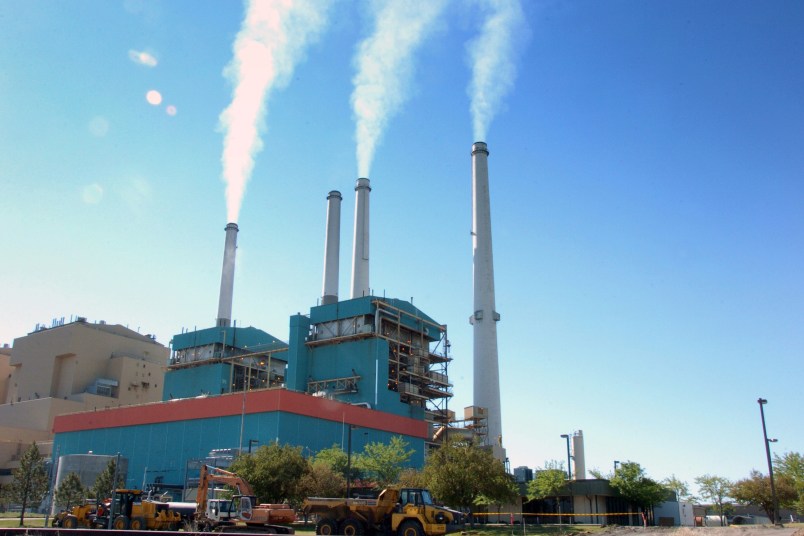BEIJING (AP) — Led by cutbacks in China and India, construction of new coal-fired power plants is falling worldwide, improving chances climate goals can be met despite earlier pessimism, three environmental groups said Wednesday.
A joint report by the groups CoalSwarm, the Sierra Club and Greenpeace follows a warning this week by two international agencies that the world needs to shift quickly away from fossil fuels to curb global warming. Environmentalists were dismayed by President Donald Trump’s U.S. government budget proposal last week that would cut spending on renewable energy.
Construction starts for coal-fired plants in China and India were down by 62 percent in January from a year earlier while new facilities starting operations declined 29 percent, according to the report. It said older plants in the United States and Europe are being retired at a record pace.
The latest developments “appear to have brought global climate goals within feasible reach, raising the prospect that the worst levels of climate change might be avoided,” said the report.
It acknowledged “the margin for error is tight.” Sustained progress will require China and India to scrap more than 100 coal plants on which construction has been suspended. And the report warned that some countries, including South Korea and Indonesia, are failing to develop renewables, which could increase their need for coal power.
In a separate report, the U.S.-based Institute for Energy Economics and Financial Analysis said falling power demand in Japan means most of the 45 new coal plants the country has planned will likely never be built.
The reports mark a shift in sentiment from six months ago, when environmentalists warned governments were doing too little to carry out the Paris climate accord. Signed by 170 countries, it calls for holding global temperature increases to no more than 2 degrees centigrade (3.6 degrees Fahrenheit) in hopes of preventing sea level rise and other drastic change.
China, the biggest greenhouse gas emitter, said then that its coal use would rise until 2030. But later data showed the peak passed in 2013 and consumption is falling.
Countries including China, Germany, India and Japan are moving away from coal as alternatives get cheaper, said Tim Buckley, the IEEFA’s director of energy finance studies.
“I don’t think Trump can stop that,” he said.
Despite such changes, the amount of heat-trapping carbon dioxide in the atmosphere rose to a new high last year and is increasing, according to the U.S. National Oceanic and Atmospheric Administration.
Asia alone is expected to account for 70 to 80 percent of the global growth in coal-fired power capacity over the next two decades.
Industry experts cautioned that countries including India, Indonesia, Bangladesh and Vietnam need to keep adding coal power because it is the only affordable option in a region where 500 million people lack access to electricity. The cost of solar and wind have fallen by up to 80 percent in some markets, but in places such as Bangladesh or parts of China it can still be double that of coal.
“We have to meet the basic needs of people while pushing for energy transition at the same time,” said Yongping Zhai, an adviser on energy to the Asian Development Bank. “You will need a mixture of different fuels. Coal will be there. You cannot avoid it.”
China canceled half its planned additional coal-fired generating capacity over the past year but will still add 100 gigawatts by 2020, according to Xizhou Zhou, who heads the Asian gas and power practice for IHS Markit, a research firm. He said Asian countries are due to add 180 gigawatts out of a global total of 210 gigawatts.
“It’s true that we are seeing a slowdown in coal plant additions, but that doesn’t mean that demand will stop increasing or that they won’t need to build coal plants,” said Zhou.
In China, construction of power plants totaling more than 300 gigawatts was suspended following last year’s release of the latest five-year economic development plan, according to the CoalSwarm report.
On Saturday, Beijing’s last major coal-fired power plant was shut down under plans to switch the Chinese capital to gas and other power sources.
China’s power demand is cooling as the government seeks to reduce reliance on heavy industry and encourage services and technology, Zhou said. That might lead to higher demand in India or Southeast Asia, however, if manufacturing of products such as smartphones that require glass, metal and other energy-intensive components migrates there.
“You have a lot of countries that could become a new manufacturing hub but still rely on coal-fired power,” he said.
India’s government said in December it needed no new coal-fired capacity until at least 2027. But industry leaders expect work to resume on power projects that have been suspended.
Analysts also warn India is just setting out on a vast and energy-hungry process of building highways and other infrastructure, while China has completed that cycle.
“What happens in India is still an open question,” said Navroz Dubash of the Centre for Policy Research, a New Delhi think tank. “It’s important not to switch from the point of view that coal is inevitable to coal is unnecessary. I don’t think we’re there yet.”
In Japan, the amount of power generated from coal should fall by 40 percent from 2015 levels by 2030 due to lower demand and use of alternative sources, the IEEFA report said.
“The economic arguments will win out,” said Paul Fisher, an economist at Cambridge University’s Institute for Sustainable Leadership. “Once the financial sector sees that it’s not in their interest to finance fossil fuels, we’ll get there.”
___
Daigle reported from New Delhi.
___
Follow Joe McDonald at http://www.twitter.com/ComradeJoeMcD and Katy Daigle at http://www.twitter.com/katydaigle .
Copyright 2017 The Associated Press. All rights reserved. This material may not be published, broadcast, rewritten or redistributed.










it’s like putting the band-aid on a paper cut and ignoring the femoral artery bleeding… I feel SO much better…
Wait … led by the Chinese?
But I thought the reason why we in the US can’t address climate change is 'cause it won’t matter 'cause the Chinese won’t do the same.
Could it be that … we’re the problem?
This is one of those cons 45 ran on his supporters; the coal jobs aren’t coming back, and it isn’t because of regulations. It is because cheaper alternatives (gas) are available, demand is declining, and sustainable options are getting cheaper. It is the market phasing away from coal. and nothing DT can do is going to change that.